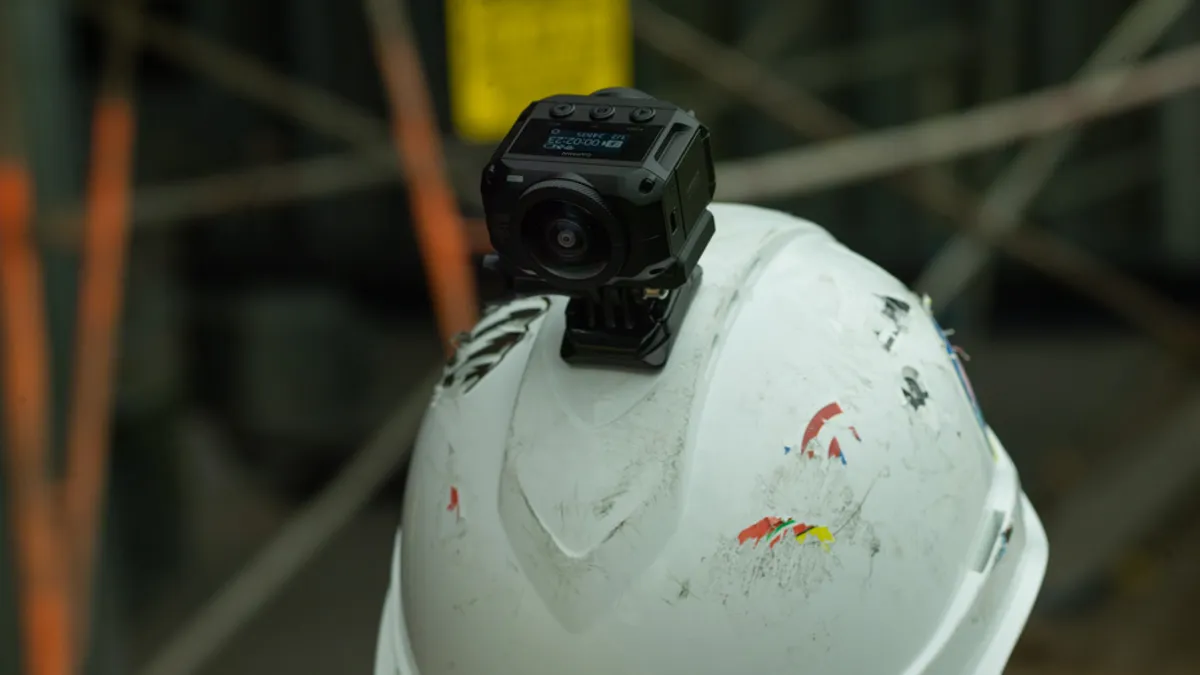Silicon Valley-based startup OpenSpace launched this week a product that it claims will dramatically cut the time it takes contractors to photograph a jobsite and share progress with key project stakeholders.
Users simply mount a consumer 360-degree camera on a hardhat, press record, and walk through a construction site. Within a day, OpenSpace artificial intelligence (AI) stitches the video footage into a 360-degree panoramic map similar to Google Street View. This process cuts by hours the time it takes to do a walk through with a standard camera.
“We’re using a lot of the same software and algorithmic techniques that are in the research world of robotics,” OpenSpace CEO Jeevan Kalanithi told Construction Dive.
Co-founders Kalanithi, Philip DeCamp and Michael Fleischman met as graduate students at Massachusetts Institution of Technology and combine backgrounds in drones, robotics and analytics. Their product uses the principle of perception, which allows a robot to understand where it is in space, and the same AI navigation capabilities that are used with self-driving cars.
While OpenSpace operates in the cloud is powered by complex technologies, the product can be used without any formal training, special infrastructure or extra requirements beyond what construction workers are doing on the jobsite.
“We focus on ‘Fitbit’ ease of use,” Kalanithi said. “It’s not a winning formula to give people more work to do to use your tool.”
Robots will not be able to outperform humans on the jobsite for a while, according to Kalanithi, but existng robotic algorithms can be used to ramp up construction workers’ productivity. “We want to be more ‘Iron Man’ than ‘Terminator,’ which means we build technology that makes people more powerful that doesn’t replace what they do,” he said.
Products and technologies that shave time off standard construction processes are in high demand amid the labor shortage. In addition to cutting down the time it takes to take process photos, OpenSpace can eliminate the need for architects, owners and other offsite stakeholders to travel to the field, the company owners said, by providing access to a virtual record of all jobsite activity.
Users can browse a project site from any location via their smart mobile device, compare progress from images taken days, weeks or months ago and tag locations with comments. A split-screen view allows users to compare images of the location at different phases of construction. For example, a contractor might compare a completed wall to a side-by-side image showing the MEP components behind the wall.
Boosting communication, accountability
Having a shared set of facts can also improve communication and accountability between owners and subcontractors, Kalanithi added. Requests for information (RFIs) and potential change orders (PCOs) can be processed more quickly because of the context that OpenSpace images can provide.
Kalanithi pointed to one example of a subcontractor who left a site before completing a task within the agreed-upon timeline, but insisted the task had been done. By pulling up the OpenSpace record, the builder was able to show that the work had not been completed and put a stop to a $50,000 PCO.
Down the road, OpenSpace plans to explore real-time data analysis to measure progress automatically, according to Kalanithi. But for now, the goal is to disrupt with minimal disruption — that is, to introduce technology that fast-tracks processes and streamlines data-sharing without adding complication.
“It’s all about giving smart, experienced people in construction the information and tools they need to make decisions faster and more efficiently,” Kalanithi said. “When you make someone more powerful rather than replace what they do, those technologies tend to win.













